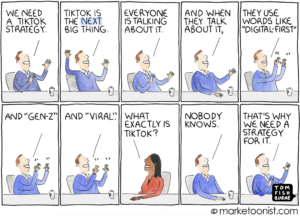Social Media FOMO: Do You Really Need a Channel for That?
Social Media FOMO: Do You Really Need a Channel for That?
In my last post, I offered six tips for choosing the right social media platform for your business. This time, we’re going to dive a little deeper and explore the “fear of missing out” (FOMO) phenomenon that drives people/companies to open a new channel when it’s neither needed nor appropriate for them.
But how do you know what warrants a new channel? Really, if you just follow the six tips I offered and look at the channel you want to open from that perspective, it’s easy to decide whether a new platform makes sense. But when faced with executives who are transfixed with the next shiny thing, or product owners and marketing campaign managers pushing for channels focused just on their babies, you sometimes need a little more ammunition to help them see that TikTok or a new X (Twitter) handle won’t deliver the results they’re seeking.
Look for your audience
If you’re dealing with “shiny object” syndrome, spend some time on the platform. See what people are doing. Look at what’s working. Does it match your brand? Does it feel like you belong there? Or will you just be howling at the moon?
Sometimes “soft” data isn’t enough to dull the shine of the latest platform, so gather stats, too. With TikTok, for example:
- 69% of the users are 13 – 24-year-olds, while those age 45 and above account for only 7% of the activity
- China has 400 million daily active users, while the U.S. has 30 million, and 1/3 of all smartphone users in India have downloaded the app
If your primary audience skews older and is primarily in the U.S., then TikTok shouldn’t be a top choice for you, but if young people is your sweet spot, then TikTok is worth exploring.
Do the math
One of the X (Twitter) channels that I used to manage had 60K+ followers, and we regularly had product marketing managers and executives who wanted to open a new X (Twitter) handle (sometimes more than one!) to amplify attention for their product. What they don’t realize, is that it takes a long time and a lot of effort and resources to grow a channel to a size that will have any meaningful impact. Whereas an existing channel with a healthy, engaged audience can offer immediate brand awareness for a new product or marketing campaign.
Put simply, an established channel + more active followers = higher reach and engagement.
This is where regular reporting comes in handy. Show them the impact your existing channel had on other campaigns. Explain how day-to-day engagement with the followers is what makes this possible, and that this takes time and energy, i.e. people to manage the channel who are regularly posting content that helps, educates, informs, and entertains. When it comes to social media, having more channels doesn’t always equal more attention.
Look at the timeframe and goal
When faced with requests to open new channels, ask the person what they hope to accomplish and why they want a new channel. Will the new handle be around long enough to justify opening it? Will the audience even understand why they should follow it versus staying with the current handle?
If it’s a short-term strategy that’s behind the push for a new channel or renaming an existing channel, then most of the time, a focused campaign on the existing channels is a better approach. Not only does it create immediate awareness with all your existing followers, it eliminates wasted time spent growing and tending a new channel that has a short shelf life.
Even if the strategy has more longevity, a new channel isn’t always the best answer (see Do the Math). Instead, consider introducing a hashtag on the topic. Just ask yourself if it’s necessary and remember, there’s no guarantee that your audience will use it. To increase the odds:
- Make sure it’s not already in use
- Use it consistently in your campaign content on the channel in question (if you don’t use it, why should they?)
Consider whether you’re covering too much
That said, sometimes a company may be trying to do too much with one handle, and it makes sense to open another one. But how do you decide whether expanding your channels makes sense?
That’s when you want to go back to the 6 tips and ask yourself:
- Will it benefit my audience to have a more focused conversation on the topic?
- Does it make sense for my company?
- What are others in my industry doing?
- Does opening another channel align with my overall social media marketing goals?
- Is it a common practice to have multiple accounts on the platform in question?
- Do I have the resources necessary to be successful?
There are definitely times when more than one account on a platform makes sense, and sometimes going for the next shiny thing isn’t just a case of “shiny object” syndrome. If you’re the San Diego Zoo, for example, going on TikTok offers a fun and unique way to engage with your followers, which makes good business sense.





